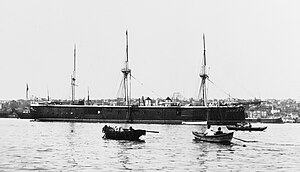 Ottoman ironclad Mesudiye
| |
| Class overview | |
|---|---|
| Name | Mesudiye class |
| Operators | |
| Preceded by | Iclaliye |
| Succeeded by | Hamidiye |
| History | |
| Name | Mesudiye |
| Builder | Thames Ironworks |
| Laid down | 1872 |
| Launched | 28 October 1874 |
| Commissioned | December 1875 |
| Fate | Sunk, 13 December 1914, by British submarine B-11 |
| General characteristics (as built) | |
| Class and type | Central-battery ironclad |
| Displacement | 8,938 metric tons (8,797 long tons) |
| Length | 101.02 m (331 ft 5 in) |
| Beam | 17.98 m (59.0 ft) |
| Draft | 7.9 m (25 ft 11 in) |
| Installed power |
|
| Propulsion |
|
| Speed | 13.7 kn (25.4 km/h; 15.8 mph) |
| Complement | 700 |
| Armament |
|
| Armor |
|
| General characteristics (1903 reconstruction) | |
| Class and type | Pre-dreadnought battleship |
| Displacement | 9,120 t (8,980 long tons; 10,050 short tons) |
| Installed power |
|
| Propulsion |
|
| Speed | 17 kn (31 km/h; 20 mph) |
| Complement | 800 |
| Armament |
|
Mesudiye (Ottoman Turkish: Happiness) was a central-battery ironclad of the Ottoman Navy, one of the largest ships of that type ever built. She was built at the Thames Iron Works in Britain between 1871 and 1875. Mesudiye had one sister ship, though she was purchased by the Royal Navy and commissioned as HMS Superb. Mesudiye's primary armament consisted of twelve 10-inch (250 mm) guns in a central armored battery.
Mesudiye was poorly maintained for most of her career, including a twenty-year long period between the Russo-Turkish War in 1877–1878 and the Greco-Turkish War of 1897. As a result, she was in very poor condition by the late 1890s, which prompted a major reconstruction of her into a pre-dreadnought design type vessel in Genoa. The ship's armament was overhauled, though the gun turrets that were to have mounted 230 mm (9 in) guns never received the weapons. A new propulsion system was also installed, which significantly improved performance.
The ship saw extensive action during the First Balkan War in 1912–1913, including the battles of Elli and Lemnos in December 1912 and January 1913, respectively. During the latter engagement, she was badly damaged by a Greek shell and forced to withdraw. Following the outbreak of World War I in 1914, Mesudiye was moored at Nara to protect the minefields that blocked the entrance to the Dardanelles. On the morning of 13 December, the British submarine HMS B11 passed through the minefields and torpedoed Mesudiye, which quickly sank. Most of the crew survived, however, and many of her guns were salvaged and used to strengthen the defenses of the Dardanelles. A battery of these guns, named Mesudiye in honor of the ship, helped to sink the French battleship Bouvet in March 1915.